Wed 11 Nov 2015
Michael Shonk: Music I’m Listening To –THE JB HORNS “Chillin’ with Fred.”
Posted by Steve under Music I'm Listening ToNo Comments
Artists: Maceo Parker, Fred Wesley, Alfred “Pee Wee” Ellis.
Wed 11 Nov 2015
Artists: Maceo Parker, Fred Wesley, Alfred “Pee Wee” Ellis.
Tue 10 Nov 2015
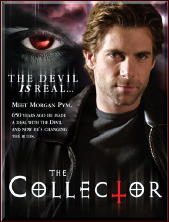
THE COLLECTOR. Syndicated: Canada, A No Equal Entertainment Inc Production, 2004-2006. 40 episodes, 60 minutes each. Cast: Chris Kramer as Morgan Pym, Carly Pope (Season One and one episode of Season Two) Sonya Salomaa (Season Two and Three), Aidan Drummond as Gabe, Christine Chatelain as Taylor Slate, Ellen Dubin as Jeri Slate, Andrew Jackson as Danny Hullstrom and Ona Grauer as Katrina. Creators and Executive Producers: Jon Cooksey and Ali Marie Matheson. Executive Producer: Larry Sugar.
After several centuries of collecting souls for the Devil, Morgan Pym convinces The Devil to let him have 48 hours to help the client redeem their soul before the Devil takes them.
Most forgotten series are forgotten for a reason, but The Collector is one of those few that deserved a better fate. Apparently it did not make a deal with the Devil since the series lasted a too short three years instead of the standard Devil deal for ten years.
Morgan Pym was originally a 14th century monk who breaks his vows when he falls in love with Katrina, a woman in the village. When Katrina dies of the plague, Morgan sells his soul for her to return to life, only to see her die a second time ten years later. This time the Devil offers Morgan the chance to be his first collector of souls.
When Morgan would get a new client from the Devil, he would have forty-eight hours to help the client redeem his or her soul. Time limits are a good device to increase suspense and tension in a drama, but The Collector went further.
Morgan did not always win, some times he did not want to save the soul but to hurry the client to Hell for the sake of others, some times the Devil would distract him or trick him from his goal. All of this made for something rare in a weekly TV series — the viewers never knew how each episode would end.
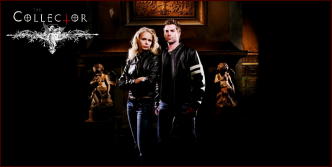
Not only were the endings uncertain, the episodes varied from comedic to theological to tragic to mystic to historic to almost any type of drama. The Collector was less interested in religion and more about the human condition. The series focused on questions such as why the client sold his or her soul, how the Devil used the request to increase the suffering of others, and how can the client with Morgan’s help redeem themselves in less than 48 hours.
The acting and production values were generally average, with star Chris Kramer one of the weakest parts of the series. But the characters and the depth of each backstory were a major strength of The Collector.
For the most part, each episode told a separate and complete story featuring the client of the week. However, some stories took time out from the main story to explore a subplot involving a young, apparently autistic boy named Gabe.
The series takes place in modern day Vancouver. Morgan lives in a rundown apartment building and has a time traveling motorcycle in his room. Now a servant of the Devil, he has a very human like love/hate relationship with a God who let the love of his life die (twice).
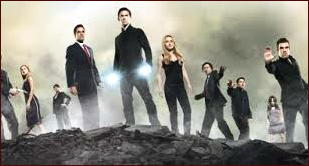
His neighbor neurotic Maya is a junkie who falls for Morgan in Season One. Morgan tries to help her get her life together but still mourns for Katrina and resists a romantic relationship with Maya. In the first episode of Season Two there is a surprise dramatic twist that results in a new actress taking over the role. Maya and Morgan’s relationship would continue to grow more serious during the rest of the series.
Local reporter Jeri Slate becomes obsessed with discovering the true identity of Morgan to the point of neglecting her son Gabe. Despite the efforts of her sister Taylor who takes care of Gabe, Jeri falls deeper and deeper into her obsession until it consumes her.
Gabe is a sullen young boy (who turned ten in season three) with unknown powers. Withdrawn and refusing to talk Gabe can draw crude pictures of events before they happen, perhaps even causing them.
When we finally learn the fate of Gabe’s father Danny Hullstrom, it deepens the mystery of Gabe. Gabe begins to search for his role, his place in life. Gabe is the only one besides Morgan who can see through the Devil’s disguises. The Devil tries to influence Gabe as his pictures often ruin the Devil’s plans. The scenes with Gabe are separate from the main story. Gabe may control the events but Morgan and the clients are not aware of it.
The Devil is the series’ most fun character, especially when played by Colin Cunningham who does the opening narration in every episode and the actor to appear as The Devil the most. A variety of actors and actress would play the part as the series had fun with the ability of The Devil to appear anywhere and as anyone including characters from past episodes.
The series ended after Season Three and left many lose ends. Why was The Devil willing to let Morgan try to help redeem his clients just at the moment he could claim them? Who is Gabe and what was his role? What would happen to those Morgan saved, how would they handle the truth about The Devil and the World?
Whether you are religious or not (I’m not) I recommend you check out this series.
Our YouTube examples (for as long as they last) include one episode from each season. First is episode six, the first time we see Gabe in action.
“The Actuary.” Written by Frank Borg. Directed by Holly Dale. Guess Cast: Rob Labelle, Alex Diakun, David Ward and Ben Ayres as the Devil. *** Client of the week is Barrett Gimbel, an Actuary who works for the local mob. Barrett had sold his soul for a machine that tells how and when anyone dies. In this funny episode the mob boss learns that the machine has said he will die tomorrow and Barrett will kill him. In a mysterious sad counterpoint we meet reporter Jill’s neglected son Gabe.
https://www.youtube.com/watch?v=8LqCG2T4V0g
In Season Two “The Mother” is an important episode in the Gabe storyline, but our example is the last episode of Season Two. This is one of the best episodes of the series as we watch Morgan learn on the job as the Devil assists him on his first collection.
“The Beginnings.” Written by Jon Cooksey and Ali Marie Matheson. Directed by J.B. Sugar. Guest Cast: Gabriel Hogan, Alan Peterson, Ona Grauer, and Colin Cunningham as the Devil. *** It is the 14th century and things look dark for humanity as the plague sweeps over the known world. Morgan and Katrina live and love. Katrina is burdened with guilt for having survived the plague while so many others have died. Morgan never tell her that he had sold his soul to save her. The ten years pass quickly and Katrina dies again. The Devil arrives and instead of Hell offers Morgan the chance to become his first collector of souls.
https://www.youtube.com/watch?v=sxWcGb2VDwk
Finally, an example of the diversity of clients and type of stories this series told. Season Three, Episode Eleven is a good spy thriller. It is also a more typical episode as it is without the Gabe subplot. For those seeking the last episode of the Gabe subplot check out “The Media Baron.”
“The Spy.” Written by Jon Cooksey and Ali Marie Matheson. Directed by J.B. Sugar. Guest Cast: Joely Collins, Martin Cummins, Wanda Cannon and Alisen Down as the Devil. *** Kandyse Crown time ends in two days and she is still trying to finish the mission she sold her soul to complete. The Devil is a female Eastern European filmmaker who is famous for her films inspiring despair and depression — a nice jab at the era’s typical Eastern Europe film style.
https://www.youtube.com/watch?v=LrF0A9I1g3g
The third season of The Collector third season has never been released on DVD, and the DVDs of the first two seasons are out of print.
YouTube offers (at this time) all fourteen episodes of Season One, and the thirteen episodes each of Season Two and Three.
UPDATE [02-06-25]: All of the videos Michael linked to when he wrote this review appear now to be defunct.
Tue 10 Nov 2015
FLIGHT TO MARS. Monogram Pictures, 1951. Marguerite Chapman, Cameron Mitchell, Arthur Franz, Virginia Huston, John Litel, Morris Ankrum. Director: Lesley Selander.
It’s difficult for me not to like movies with Cameron Mitchell in them. Sure, he did more than his fair share of lousy films, but the man’s got a unique presence and a wry, world-weary manner of speaking that’s difficult to explain: a sort of you-know—it-when-you-hear-it.
So when I learned of this science fiction B-film that stars not only Mitchell, but also Arthur Franz (another favorite of mine from that era and that genre), I had to check out Flight to Mars. The result: well, let’s just say that’s a clumsy, superficial film without much to recommend it except that the movie has these two actors in it and that it makes great use of Cinecolor.
The plot, evidently borrowed from the silent Soviet film, Aelita (1924), follows a group of American scientists, as well as newspaperman Steve Abbott (Mitchell), as they make their way to the red planet. When they arrive, they discover a highly advanced civilization led by a quasi-fascist regime led by the authoritarian Ikron (Morris Ankrum).
So everyone runs around a bit through the hallways of the Martians’ underground city, all wearing similar cheap looking uniforms (apparently the costume budget for this movie wasn’t all that elaborate), and then our friendly group of earthlings finally discover a means by which they can fix their rocket ship and head back home.
That’s really about it. It’s a shame, for merely adding a little green man or two to the mix would have really spiced things up a bit.
Still, I imagine that if you were a kid in the early 1950s and you saw this at a matinee, you would have thought it was all super neat. And you may not have been half wrong, either.
Tue 10 Nov 2015
A live version of the first song on jazz singer Karrin Allyson’s CD In Blue (2002).
Mon 9 Nov 2015
This one day pulp and paperback convention has been an annual event for over a dozen years and has been held at the Ramada on Route 206 near the NJ Turnpike exit in Bordentown, NJ. Frankly, I don’t think Rich Harvey has received enough credit for his dedication in putting on this convention each year. He has even started to do a one day show in Florida during the winter.
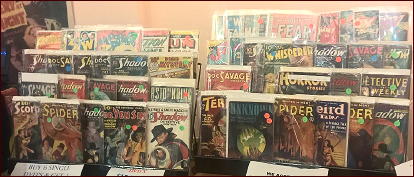
In addition to pulps and paperbacks, the 47 tables also held pulp reprints, slick magazines, dime novels, DVDs of old movies, and original artwork. There were over a hundred attendees and the room always looked crowded and busy during the day. In addition to Rich Harvey, author Audrey Parente also was helping out and things were run very smoothly with many dealers coming from as far away as Boston, Connecticut, Maryland, NY, and even Florida. Restaurants and hotels were within easy reach.
Though this is a one day convention, for the past several years it has been a four day event for me and some fellow collector friends. For instance Matt Moring, who runs Altus Press and owns much of the old Munsey and Popular Publications, comes down for a visit starting the Wednesday before the convention and spends several days meeting with us doing research.

Digges La Touche, otherwise known as The Reading Machine and The Major, is a great pulp resource and along with me, we discuss with Matt all sorts of ideas involving the pulps and even the slicks. This time we drove Matt to distraction talking about H. Bedford Jones best series which most collectors do not even known about, the Pinky Jenkins novellas that were published in Ace High in the 1920’s.
We also talked about some of the great slick magazine series like the Glencannon stories by Guy Gilpatric and the Scipio series by Clarence Buddington Kelland. These literary discussions took place not only at my house and up at Digges’ brother’s place but also at the various local restaurants.
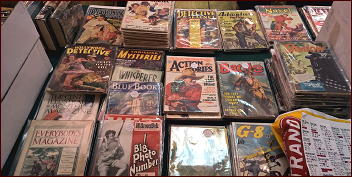
I’ve also gotten into the habit of hosting a pulp luncheon for collectors who arrive early on Friday and stay overnight at the Ramada for the Saturday show. These luncheons are attended only by serious, and I mean really serious, readers and collectors. This year in addition to myself, the discussions held the rapt attention of Matt Moring, The Reading Machine, Ed Hulse, and dealers Nick Certo, Scott Hartshorn, and Paul Herman.
Legendary collector and dealer Jack Irwin also attended and the day before had provided several of us some much needed reading matter when we visited his storage facility which non-collectors call a house. I’ve known Jack since the 1960’s and he has been collecting pulps for over 70 years.
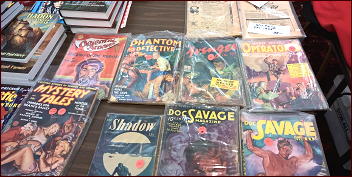
Digges picked me up at 7:30 am on the day of the convention and by 8:15 we were in the dealers room of the Ramada looking through piles of pulps, digests, paperbacks, and slicks. Though the official opening time is 10:00 am, many tables set up quite early and fellow dealers visit each other. We would have been there earlier but the city of Trenton was shut down by what looked like the entire police force as they blockaded many of the streets. Some type of marathon. You know, the usual non-collector waste of time. I never will understand non-readers and non-collectors.
I had a table and proceeded to dump several boxes of books and pulps. I must have brought a couple hundred hardcover detective and mystery novels that I had read and no longer wanted. Also over 50 banged up pulps. Since I wanted to sell everything, I priced everything at one dollar each. That’s right, everything was a buck! Evidently no one believed me because I sold only 18 hardcovers and made $18.00.

At the end of the show, since I was threatening to throw the contents of the entire table into the dumpster, I gave away all the hardcovers to fellow readers. Every collector has a non-collector who is in charge of harassing them about their collection of books, and I had told my non-collecting spouse that these books were making a one way trip and would not be returning to our house.
But don’t feel sorry about my lack of money-making skills. First of all, I found a pulp cover painting for a reasonable price. The photo shows me holding it and it is the cover from a 1934 Western Story. The artist is Frank Spradling, and it is quite unusual, as it shows a nighttime scene that must have happened a million times out west. A cowboy hears a noise at his campfire and reaches for his gun.
Several books made their debut at this convention. The latest of Ed Hulse’s Murania Press volumes was available. It’s a reprint of a Dime Mystery novel from 1933 by William Corcoran called The Purple Eye. Altus Press had several new collections from their Dime Detective Library, including one of the best and most unusual series, the Jeffery Wren series by G.T. Fleming-Roberts. It stars the best of the magician detectives and includes an introduction by Fleming-Roberts’ son.
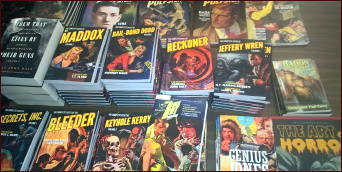
But the most noteworthy debut was the stunning blockbuster collection from Altus Press titled Them That Lives by Their Guns. It’s volume one of the collected hard-boiled stories of Race Williams by Carroll John Daly, creator of the hard-boiled detective story. This large book has 654 pages and is only $29.95. All of the stories, except one, are from Black Mask, 1923-1927. There is a long introduction discussing the pros and cons of Daly’s work. This is a must buy volume of historical significance and though Race Williams is a murdering SOB, every pulp reader and collector should have this collection. I’m sure we will be seeing some interesting reviews from both lovers and haters of Daly’s work.
I’ve saved the best for last. You may wonder about the photos showing horror and fantasy writer Chet Williamson and me holding up four old issues of All Story. Chet bought these 1913-1914 issues 37 years ago and decided to sell them to me, thus completing my 444 issue set of All Story. It’s been a quest that I’ve been involved in for many decades and I now have probably the only complete set in existence.
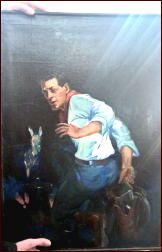
Many collectors complain about the trials and tribulations of collecting the weekly pulps. I’m talking about not only All Story, 1905-1920, but also Western Story, 1919-1949, Detective Story,, 1915-1949, Detective Fiction Weekly, Argosy, etc. I collect and read all these magazines and have managed to compile extensive runs.
Instead of finding it a terrible and expensive job, I have enjoyed myself tremendously and I don’t regret the money that I’ve spent on these magazines. It’s been a load of fun and I’ve tried to get that enjoyment across in my series of articles called “Collecting Pulps: A Memoir”.
I stress *read* because there actually is quality fiction in these old magazines. Don’t believe ignorant literary critics that lump all the pulps together as sub-literary. There actually is such a thing as a good pulp magazine, and that’s why I’ve been collecting them for most of my life. There are bad titles also, but that’s another story.
So ended several days of meeting with old friends, talking about books, pulps, and old movies. There is no better way to spend our time. Collecting books is a lifelong activity and you may retire from a job or a profession but you never retire from collecting. I urge all readers and collectors to support the Windy City Pulp Convention and Pulpfest. They are great fun!
Editorial Note: Thanks to Sai Shankar for the use of the photos.

Sun 8 Nov 2015
MARGARET MARON – Bootlegger’s Daughter. Deborah Knott #1, Mysterious Press, hardcover, 1992; paperback, June 1993.
Margaret Maron is the author of seven novels featuring Sigrid Harald, as well as one non-series mystery. I understand that we’ve seen the last of Harald for a while, and that Maron will concentrate on Deborah Knott.
Fine with me; I liked the Harald stories well enough to read and acquire them, but I think Bootlegger’s Daughter clearly represents a move up in the craft.
Deborah Knott is a 34 year old attorney who has entered the Democratic Primary for the position of District Judge. Her father is (was?) the best known bootlegger in that part of North Carolina, and they are currently somewhat estranged due to his opposition to her political ambitions.
Just prior to election day, an old (unrequited) love comes to her for help The story of course deals with her journey into the past in search of answers, but it is much more than just a mystery to be solved. It is the story of a woman trying to enter a man’s world in the old south, and indeed an evocative depiction of the people and culture of a piece of that part of our country.
I know North Carolina only slightly, but know the rural south well, and found the milieu to be finely and accurately drawn. Deborah herself is an appealing character, a strong and determined woman who I believe will find favor with most readers. I look forward to meeting her again. A very good book, recommended highly.
A final note: on the back of the dust jacket are no less than seven favorable and well deserved advance comments by fellow mystery writers, and I was struck by the fact that they were all by female authors. Hmmm. One isn’t quite sure what to infer. Do Maron/Mysterious Press consider this primarily a “woman’s” book? Surely not, though that’s the most obvious implication. I would think it almost has to be a marketing decision of some kind. Oh, well.
The Deborah Knott Series —
Bootlegger’s Daughter, 1992
Southern Discomfort, 1993
Shooting at Loons, 1994
Up Jumps the Devil, 1996
Killer Market, 1997
Home Fires, 1998
Storm Track, 2000
Uncommon Clay, 2001
Slow Dollar, 2002
High Country Fall, 2004
Rituals of the Season, 2005
Winter’s Child, 2006
Hard Row, 2007
Death’s Half-Acre, 2008
Sand Sharks, 2009
Christmas Mourning, 2010
Three-Day Town, 2011 (cross-over with Sigrid Harald)
The Buzzard Table, 2012
Designated Daughters, 2014
Long Upon the Land, 2015
Note: Sigrid Harald made two additional appearances after the Deborak Knott series began: Fugitive Colors (1995) and the crossover novel noted above. Bootlegger’s Daughter won the 1992 Agatha and the Anthony, Edgar and Macavity awards for “Best Novel” the following year.
Sat 7 Nov 2015
THE HOWARDS OF VIRGINIA. Columbia Pictures, 1940. Cary Grant, Martha Scott, Sir Cedric Hardwicke, Alan Marshal, Richard Carlson, Paul Kelly. Director: Frank Lloyd.
During his long and storied film career, Cary Grant appeared in films of different genres and portrayed a wide array of characters. It’s very easy to close one’s eyes and picture Grant in a screwball comedy or as a soldier and spy. What about as a backwoods Virginian adorned in Daniel Boone attire? That’s more difficult, wouldn’t you say?
But somehow, kind of, sort of, Grant manages to pull it off.
That’s a statement that could be applied in general to The Howards of Virginia, a slightly above average historical melodrama set in Virginia during the colonial era and the American Revolution. Based on Elizabeth Page’s novel, The Tree of Liberty, the movie features Grant in a starring role. He portrays Matt Howard, a man of western Virginia who falls in love with and marries Jane Payton (Martha Stewart), a woman from the Tidewater aristocracy.
The movie traces the couple’s relationship from its tumultuous beginnings through their settlement in a western Virginia tobacco plantation, Howard’s election to the Virginia House of Burgesses, and the Revolutionary War. Although the film is unevenly paced, it ends up all coming together by the end. The last half hour of the film, in which Grant’s character really comes into his own, makes sitting through a rather sluggish first hour worth it.
All told, while The Howards of Virginia is no forgotten classic begging to be rediscovered, it’s nevertheless a significant entry in Grant’s early film career and a surprisingly gritty portrayal of soldiering during the campaign for American independence.
Sat 7 Nov 2015
DAVID HILTBRAND – Deader Than Disco. Avon, paperback original, April 2005.
Here’s the first paragraph of my review of Hiltbrand’s first mystery, Killer Solo, which came out in January, 2004:
Deader Than Disco, Hiltbrand’s second novel, also marks the second appearance of rock ’n roll detective Jim McNamara. I may as well say, up front and for the record, that Killer Solo is the better of the two, but with no other contender in sight, that leaves the first book still in the top position.
Although other real life people in the world of show business (Gwenyth Paltrow, Sheryl Crow) are mentioned in passing, McNamara’s client is only an excellent clone (and reasonable facsimile) of singer superstar Madonna, a lady named Angel (last name Chiavone), who’s deeply involved with the murder of a superstar pro basketball player in her home, after a party, and she is strictly not talking about it, not to any one, and certainly not to McNamara, who was actually hired by Angel’s publicist, a lady named Lani.
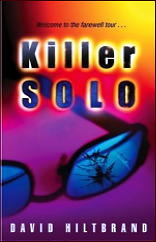
McNamara’s own demons, the ones that forced him out of active show business himself, drinking and a bad drug problem, are past him, and yet not entirely. He finds AA meetings to attend wherever he goes, which in this book includes a long stint in Hollywood, followed by a shorter one in Manhattan, and all the while keeping in touch with his sponsor back in New England. The latter being, by the way, a very good way of having someone around to bounce ideas off of.
As a writer, Hiltbrand has a neat way of characterizing his characters quickly and sharply, even the ones who are only passing through. About 80% of McNamara’s investigation goes down well, but once he decides that the decamped diva has disappeared off to Detroit (well, Michigan, but it doesn’t match the alliteration) – and how’d he know, I do not know – all of the well-characterized characters fade into the background. With at that point only three players to play around with (Angel, MacNamara, and the killer) the well-honed tale (up to then) fritters itself away into a badly rehearsed made-for-cable late night thriller.
Chapter 40 begins with “It took a while to sort things out.†But unlike some complicated detective stories with lots of twists and turns in the plot, three more pages and it’s over.
Bibliographic Note: The third and final Jim McNamara novel was Dying to Be Famous (Harper, 2006).
Fri 6 Nov 2015
THE NEANDERTHAL MAN. United Artists, 1953. Robert Shayne, Joyce Terry, Richard Crane, Beverly Garland. Written by Aubrey Wisberg and Jack Pollexfen. Directed by E. A. Dupont.
It would be easy to pick at this shabby film for the confused story, wooden acting and choppy continuity — I mean how tacky is it when the movie credits misspell the name of the top-billed actor? And as long as we’re carping, there’s the scene where Beverly Garland walks into the background and is replaced by another actress, or the muddled montage where a sabre-tooth tiger attacks a car, intercut with footage of a bobcat and something hitting the windshield that looks like a suction-cup Garfield. And don’t let’s forget the stiff and unconvincing rubber mask that’s supposed to be a primitive beast-face.
Robert Shayne is remembered these days as Inspector Henderson on The Adventures of Superman but he did his share of Mad Doctoring in things like Face of Marble and The Indestructible Man. Here he gets to pull out a few stops and rave in the approved Lugosi style as a scientist (in what field I’m not exactly sure, and I suspect the writers weren’t either) who believes Neanderthal Man was our intellectual equal — a motif in some recent TV Commercials — and has developed a serum that will regress stuff.
As the film opens, he has used this on a house cat and a housekeeper, and when he tries it on himself he turns into the frozen-faced boogeyman of the title, lumbering amok about the countryside trying to make things lively.
The first disturbing element comes when he carries off a local gal and (it’s pretty clearly implied) brutally rapes her. But later on, after he abducts a waitress and they spend the night in a cave, she comes out in the morning and begs the surrounding posse to spare his life. Which makes one wonder just what went on, but I suspect that here again the writers had no idea.
For me though, the most unsettling part came earlier, in the standard scene where Shayne is being scoffed at by his scientist-peers after showing them a display that “demonstrates†how Neanderthal was more advanced than Cro-Magnon, and when they ask him for proof, he calls them stupid.
A silly scene, poorly written, but something about the temper of our times made it resonate with me. There are people coming on national TV these days who publicly boast that they can’t understand Evolution and want us to elect them President.
There are others who call us stupid if we ask for proof of what they say — as I sat watching the Mad Doctor spouting the same clichés about being misunderstood, I almost expected him to blame the Liberal Media.
And it got me to wondering if some of the public figures of these days maybe watched too many late-late shows. Or has public discourse moved to the level of a cheesy old horror flick? Which may be the scariest thing we’ll see this Halloween.
Pleasant dreams, children…..
Thu 5 Nov 2015
Craig Rice (1908-1957) is something of an acquired taste. She was immensely popular in her heyday, so much so that Time magazine made her the subject of a cover story back in 1946, and her reputation was still high enough more than forty years after her death that a book-length biography was written about her (Jeffrey Marks’ Who Was That Lady?).
Thanks to publishers like Rue Morgue Press, at least a few of her novels are still available today, but no one would call her a posthumous bestseller. What made her stand out among her contemporaries was the way she blended traditional whodunit elements with the kind of wacky humor one associates with Hollywood screwball comedies. In an earlier column I discussed her debut whodunit, 8 Faces at 3 (1939). This time I tackle her second.
The Marks biography doesn’t tell us whether Rice worked directly in radio before turning to novels. But she did serve for brief periods in the late Thirties as radio critic for a small midwest magazine, so it’s no surprise that the background of The Corpse Steps Out (1940) is a Chicago station. Its sensational singing star Nelle Brown, married to an ex-millionaire more than twice her age but (although Rice treats the subject discreetly) rarely without at least one lover in her own age bracket or younger, is being blackmailed by a former paramour on the basis of some, shall we say, erotic letters she wrote him.
Between the regular broadcast of her musical variety show and the re-broadcast for the west coast, she sneaks off to the man’s apartment and finds him shot to death and the letters gone. She goes back to the station and tells her press agent, Jake Justus, whom we first met in 8 Faces at 3.
Jake pays his own visit to the apartment and finds the corpse has vanished. Pretty soon Jake’s girlfriend and soon-to-be wife Helene Brand and the rumpled liquor-sodden attorney John J. Malone, both also familiar from Rice’s earlier novel, are running around with Jake to find the body, save Nelle Brown’s radio career, expose the murderer, and drain Chicago of its liquor supply.
No one ranks The Corpse Steps Out among Rice’s greatest hits but it’s often bracketed with her mystery-as-screwball-comedy titles. Not by me. The body of the first of three murderees is moved around Chicago twice and that of the second once, but there’s nothing wildly humorous about these developments. I’d call the book a fairly straightforward whodunit, impossible for any reader to solve ahead of the protagonists and pockmarked by one huge coincidence: Jake and Helene are driving past a certain old warehouse when they notice it’s on fire and Jake for no good reason breaks into the building and finds the corpse he’s been looking for.
True, the proceedings are punctuated here and there by screwball dialogue. In Chapter 10 Jake settles down in the apartment he’s temporarily sharing with Helene. “I love our little home, dear….Where shall we hang up the goldfish?†In Chapter 28, as the end comes near, Malone assures Jake that “we’re leaving no turn unstoned.†To which Helene replies: “That’s wrong….[W]e’re leaving no worm unturned.â€
Genuine Hollywood screwball comedies tended to dwell on sexual innuendo but Rice keeps it to — dare I say it? — a bare minimum. About to take off on a nuptial trip with Jake, a somewhat casually attired Helene says: “I’d better get dressed, unless you don’t mind my being married in pink pajamas.†To which Jake replies: “It would save time….â€
He’s much more of an acquired taste than Rice, but my favorite among wacky mystery writers based in Chicago (or anywhere else) is Harry Stephen Keeler (1890-1967), whom I’ve loved since my teens. Besides having the Windy City in common, Keeler and Rice shared the experience of having been institutionalized, he early in life, she later. When he was about 20, Harry’s mother for unknown reasons had him involuntarily committed for more than a year.
That period had a lasting effect on his novels. In The Spectacles of Mr. Cagliostro (1926) Jerry Middleton, heir to a Chicago patent-medicine fortune, is replaced by an impostor and railroaded into the state mental hospital where he’s befriended by the genuine madpersons, sweet souls one and all, and nearly killed by an assassin who‘s been hired to get admitted to the asylum and slice him up. The scene where Jerry is analyzed by that world-renowned shrink Herr Doktor Meister-Professor von Zero is probably the most hilarious lampoon of Freud ever committed to print.
About a dozen years later Keeler revisited the nuthouse theme in the novel published in two volumes as The Mysterious Mr. I (1938) and The Chameleon (1939). The nameless narrator is on a mission to collect $100,000 by returning an escaped millionaire to the loonybin before midnight. On his quest he trips blithely through close to a hundred identities, posing in turn as a tycoon, a safecracker, a locomotive engineer, a gambler, several different detectives, several authors, a couple of actors and a philosophy professor — just to name a few! — before this forerunner of The Great Impostor returns to the asylum where, as he assures us, he’ll spend the rest of his days reading British magazines and sipping Ch teau d’Yquem with his keeper.
At the end of The Corpse Steps Out, which appeared about a year after The Chameleon, Rice offers a similarly benign take on asylums:
Malone: “No, a pleasanter place.â€
Murderer: “A quiet room in a pleasant place, with a radio set perhaps….I couldn’t ask for much more.â€
Severe alcoholism and several manic-depressive and suicidal episodes led to Rice herself spending part of her last years in California’s Camarillo State Hospital and other institutions. I doubt that she found them the pleasant places she and Keeler had once conjured up. As critic William Ruehlmann has said, she wrote the binge and lived the hangover. Poor woman.